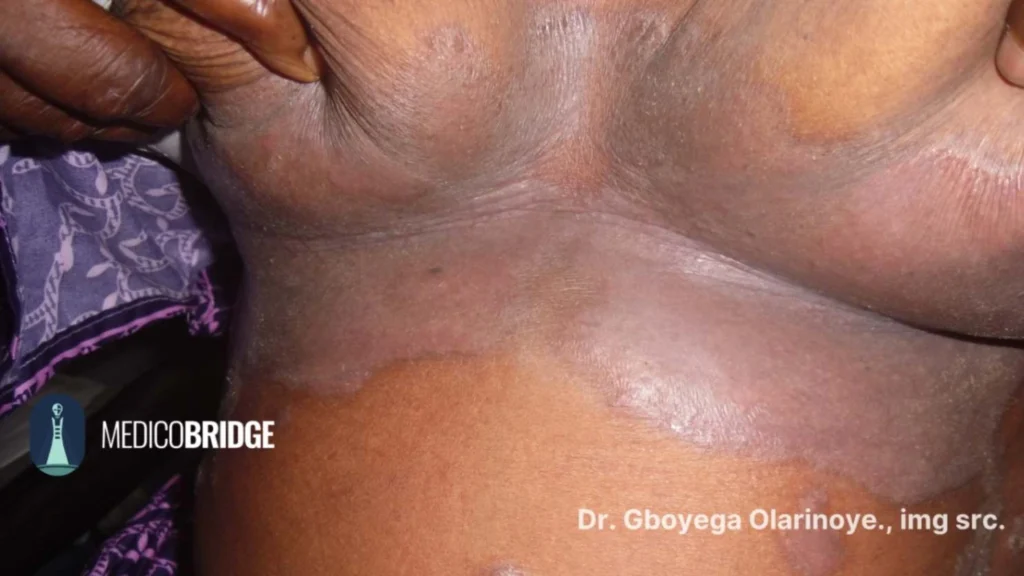Author's details
- Hakim A Abubakre
- BA (Hons) International Business Management, Msc Digital Marketing.
Reviewer's details
- Dr. Khashau Eleburuike
- MBBS (Ilorin) MSc. Global Health Karolinska Institute.
- Resident doctor in family medicine in Northen Sweden.

- Date Published: 2025-06-15
- Date Updated: 2025-06-15
Erythrasma – A Common Skin Infection
🩺 What Is Erythrasma?
Erythrasma (also called cutaneous erythrasma) is a long-lasting skin infection caused by a bacteria called Corynebacterium minutissimum. It is very common in Sub-Saharan Africa because of the hot weather and moist skin.
Many people have this infection but do not go to a clinic, and so it often gets ignored.
🔍 What Causes Erythrasma?
The bacteria grow in warm, wet areas of the body, especially where skin touches skin.
People are more likely to get it if they:
- Sweat a lot
- Are overweight or obese
- Have diabetes
- Have dark skin
- Are older
- Do not bathe regularly
- Live in shared spaces
- Have a weak immune system (like people living with HIV)
👀 What Does It Look Like?
You may see:
- Pink, red, or brown patches
- Dry or scaly skin
- Wrinkled or soft skin
- Cracks between toes
- Itching or burning, especially in the groin
- A bad smell in some cases
On dark skin, it may look like a lighter patch with darker edges.
Common places affected:
- Underarms
- Groin (between the thighs)
- Under the breasts
- Between the buttocks
- Belly button
- Thighs
- Between the toes
It can also appear in folds of fat on the stomach or legs.
👨 Men often get it in the groin, while 👩 women get it more often under the breast, groin and between the toes.
⚠️ When Should You See a Health Worker?
Go to a clinic or hospital if:
- You have brown or reddish patches that itch or burn
- The patches are in moist or sweaty areas
- The rash is not going away with self-care
- You have diabetes or HIV
- The skin starts peeling or blistering
- You have a fever or feel unwell
- You have swelling or difficulty breathing
🧼 Self-Care and Treatment
✔️ What You Can Do:
- Wash daily with antibacterial soap
- Keep skin clean and dry
- Use baby powder in skin folds
- Wear light, loose, and clean clothes
- Eat healthy foods
- Lose weight if overweight
🧴 Medicines That Help (use as advised by a health worker):
Creams: antibiotic or steroid cream
Pills in the form of antibiotics
❗ Always finish the full course of medicine, even if the rash improves early.
🛡️ How to Prevent Erythrasma
- Bath or shower every day
- Dry skin well after bathing
- Wear cotton clothes that soak up sweat
- Change underwear and socks daily
- Avoid tight clothing
- Stay cool—avoid very hot or damp places
- Keep blood sugar under control if you have diabetes
- Maintain a healthy weight
💬 Important to Know
Erythrasma is not:
- Witchcraft
- A curse
- A sexually transmitted disease
It is a common skin infection. With the right treatment, it can go away.
- World Health Organization (WHO) – Skin Diseases in Tropical Countries, 2023
- Hay RJ et al. (2014). Skin Diseases in Africa: Common Skin Infections and their Management
- Nweze EI, et al. (2022). Prevalence of superficial skin infections in Sub-Saharan Africa
- Centers for Disease Control and Prevention (CDC) – Bacterial Skin Infections Overview
- Cardillo, H., Kohler, J., Kriner, E. and Mehta, K., 2014, October. Applications of Wood’s Lamp technology to detect skin infections in resource-constrained settings. In IEEE Global Humanitarian Technology Conference (GHTC 2014) (pp. 548-554). IEEE.
